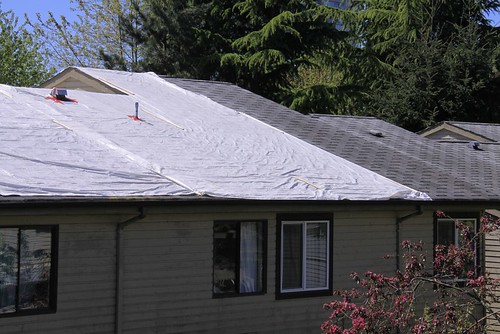When roofs are exposed to extreme weather conditions and severe elements such as ice, snow, rain, wind and intense heat, they can become easily damaged. However, detecting a leak early on can minimize severe problems in the roofing system, and reduce the amount of cost to repair or replace.
Unfortunately, detecting a leaking roof is often difficult. This is because water leaking into it often travels on the underside of rafters and plywood before being absorbed into the insulation. Often times, the damaged area in the ceiling below is nowhere near the leak on the roofing system above. Because of that, it is often essential to hire a roofing services contractor that can detect the leaks, and make recommendations on repair and replacement.
Locating Leaks
Any obvious sign of a missing piece of concrete tile or asphalt shingle is usually an indicator of a major leak. This type of damage often requires immediate replacement or repair as a way to stop water that penetrates into the structure. Signs of any water leakage are often easier to protect on a rainy day. This is because a flashlight will reflect wetted areas on insulation, rafters and plywood in the attic.
When the building does not have an attic, most companies often look for detectable signs of leaks occurring in common places. Some of these include:
• The Ridge Cap – Most roof systems have an installed ridge cap along the top of the roofing system. Often times, these caps will break from expansion of built-up ice, or the destructive powers of blowing debris.
• Boots – Air vents, plumbing vents, electrical wiring and exhaust fans often penetrate the roofing structure to the outside. Because of that, licensed companies will install a “boot” as a way to provide protection of the roofing system by creating a barrier against the elements. Over time, these boots can dry out, develop issues or begin to fail due to increment weather. These contractors will look for any detectable sign of crack sealant/caulking, deteriorated roofing gasket, or any obvious opening that would allow the penetration of water.
• Flashing – Heavy metal flashing is often installed at any location where a sidewall of the building meets the roof, including chimneys. Many times, weather conditions will dry out the ceiling and caulking attached to the flashing, and allow water to penetrate into the attic or structure below.
• Gutters and Gutter Downspouts – Any clog within a gutter or downspout system filled with debris or leaves can provide the perfect environment for ice and water to back up into the roof before making its way into the attic and ceiling below. It is essential to ensure that the gutter system is operating properly to minimize any damage to the structure.
• Dormers – A valley is created when the exterior roofline meets a top-story dormer, increasing the opportunity for a potential leak. This is because the materials can easily pull away from the dormer and allow water to penetrate into the attic or ceiling below.
Making Necessary Repairs
Contractors that offer roofing services are highly skilled at performing repairs and replacements of the roof. This is important because there is often need to work in dangerously high areas. With an annual inspection, many serious issues involving the roofing system can be avoided. Any early detection of missing shingles, wear and tear, or other roofing issue can minimize the costs involved in repairing or replacing the components.
The top of any structure remains a critical component to the building’s functionality and longevity. It provides year-round protection against the outside elements. To remain functional, it requires routine inspection and detection of any leak in the system.

